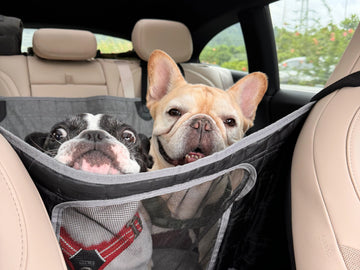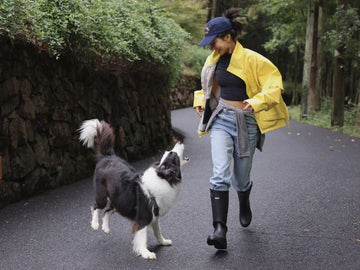Updated: October 2025 · Read time ~14–18 minutes
Plane rides get the headlines, but most American pets travel by car. The good news: with a little pre-trip training, the right safety setup, and a realistic packing plan, road-tripping with a cat or dog can be calm, efficient, and (dare we say) fun. This guide distills current U.S. best practices—crash-tested restraints, state-level quirks, motion-sickness options, and a field-tested kit—so you can focus on the miles, not the mess.
1) Safety baseline in 60 seconds
- Restrain in the back seat—either in a crash-tested harness that clips to the seat belt, or a secured, crash-tested crate in the cargo area. Airbags are designed for humans; the front seat is a no-go for most pets.
- Pick equipment with real test data. For harnesses, look for models independently certified by the Center for Pet Safety (CPS). For crates, use strength-rated tie-downs—no free-floating plastic carriers.
- Windows up for safety. Wind, grit, and insects can injure eyes/ears; heads-out is Instagrammable but risky. Moderate A/C and a window shade beat a drafty window.
- Never leave pets in a parked car—even “for a minute.” Interior temps can spike fast; many states also have “hot-car” laws and Good Samaritan provisions.
2) Laws & “gotchas” by state
There’s no federal “seat-belt for pets” rule, but several state laws matter for road trippers:
- Open truck beds: In states like California, it’s illegal to transport animals in an open pickup bed on the highway unless specific containment or cross-tethering conditions are met.
- Driver distractions / pets on laps: Hawaii explicitly bars animals on a driver’s lap. A handful of other states cite animals under “obstruction” or distracted-driving language even without a pet-specific statute.
- Open-air vehicles (Rhode Island): Requires pets in open-air motor vehicles to be enclosed, under another person’s control (not the driver), or safely restrained with a harness (not a neck restraint).
- Hot-car protections: A majority of states penalize leaving animals in dangerous temperatures; some also offer Good Samaritan immunity rules for rescuers who follow specific steps.
Bottom line: restrain in back, avoid open beds, and plan your rest stops to avoid heat/cold exposure. When crossing state lines, assume the stricter rule applies.

3) Car setup that actually works
Back-seat harness (dogs)
- Choose a crash-tested harness with three-point attachment that keeps the torso upright and limits rotation during hard braking.
- Clip to the vehicle’s seat-belt system—not to cargo hooks or child-seat LATCH anchors that aren’t rated for pet loads beyond car seats.
- Fit is everything: re-check after grooming or weight changes.
Crates & carriers (dogs & cats)
- Pick a crash-tested crate and secure it with strength-rated tie-down straps; position laterally against the backseat or the cargo bulkhead to reduce movement.
- For cats, a rigid, well-ventilated carrier placed cross-wise on a grippy mat lowers vibration and motion cues.
- Line with a thin bed + pee pad; too much padding increases heat and nausea.
Climate & light
- Use sunshades and set A/C slightly cooler than your normal comfort range.
- Avoid “heads-out” windows; use a 6 ft leash and ID tags when doors open.
- Pack a clip-on LED for dusk arrivals and a reflective leash for dark campgrounds.
4) Master packing checklist (with U.S. equivalents)
Here’s a modular kit you can copy/paste into your notes app. Items in bold are “don’t skip.”
Food & hydration
- Base diet (kibble / fresh / dehydrated) in pre-measured zip bags; sudden switches = tummy trouble.
- Travel-friendly add-ons: shelf-stable complete wet food or freeze-dried toppers.
- Water (1–2L extra) + collapsible bowl; assume remote stops won’t have potable taps.
- High-value treats (training & desensitization; also useful for quick photos!).
Supplements (U.S. common)
- Joint support (glucosamine/chondroitin), omega-3s, as directed by your vet.
- GI support: dog-safe probiotics for sensitive stomachs.
- Condition-specific: CoQ10 (cardiac), as advised by your veterinarian.
First-aid & health
- Saline for eye/skin rinsing; povidone-iodine for wound cleaning; antimicrobial ointment.
- Tick tool, small bandage roll, non-stick pads, self-adhesive wrap, blunt-tip scissors.
- Alcohol wipes for instruments (not for open wounds), small bottle of hydrogen peroxide for surface disinfection (do not use to induce vomiting unless a vet instructs you).
- Cooling cloth in summer, light blanket in winter.
Medications (talk to your vet first)
- Motion sickness: veterinary maropitant (Cerenia®—Rx) is commonly used; some vets may suggest dimenhydrinate or meclizine for certain dogs. Give only on vet guidance.
- Anxiety adjuncts: your vet may recommend an anxiolytic (e.g., gabapentin/trazodone) for travel days—trial at home first.
- Chronic meds (dry-eye drops, cardiac meds, etc.): pack a full course + 3 spare days.
Grooming & clean-up
- Chamois towel / quick-dry towel; grooming wipes; pet-safe dry shampoo.
- Waste bags, paper towels, enzyme cleaner, 3–4 pee pads.
- Comb/brush; nail file; small lint roller for hotel courtesy.
Safety & restraint
- Crash-tested harness (back-seat) or crash-tested crate (cargo) + strength-rated tie-downs.
- 6-ft leash + backup slip lead; reflective set for nights.
- Well-fitting chest harness (easier to control at gas stations than a collar alone).
- Vehicle cover / hammock that doesn’t interfere with seat-belt function.
Documents & ID
- Rabies certificate, vaccine record, microchip number, recent photo.
- Emergency vet list (1–2 clinics along your route, 24/7 if possible); pet insurance card.
- Hotel pet policy printouts / reservation numbers.
Nice-to-haves
- felt charm keychain—use it as a cheerful ID tag on a harness or carrier handle (bonus: easy to spot at night with a clip-on LED).
- Seat-back organizer for meds, wipes, bowls; small trash caddy.
- Portable fan for shaded picnics (never a substitute for A/C in a car).
Road Trip Pet Packing Checklist (Printable)
Tip: Copy this list into your notes app or print it out. If your drive connects to a flight, check our airport guide: pet travel news today 2025.
| Category | Item | Suggested Qty | Packed? | Notes (U.S. guidance / remarks) |
|---|---|---|---|---|
| Food & Hydration | Main diet (kibble, fresh, or dehydrated) | Trip days + 3 | Pre-measure in sealed bags; avoid sudden food changes to prevent GI upset. | |
| Food & Hydration | Wet food or freeze-dried toppers | 1–2 pouches/day | Shelf-stable and complete formulas travel best. | |
| Food & Hydration | Collapsible bowls (food & water) | 2 | Silicone or BPA-free plastic; quick-dry and easy to rinse. | |
| Food & Hydration | Drinking water supply | 1–2 L extra | Some rest stops lack safe taps—carry your own. | |
| Food & Hydration | Training treats / rewards | 1–2 small bags | Useful for calm behavior and travel photos! | |
| Supplements | Joint support or omega-3s | Trip days + 3 | Common formulas: glucosamine, chondroitin, fish oil—use vet-approved brands. | |
| Supplements | Probiotics (gut support) | Daily | Helps sensitive stomachs during travel transitions. | |
| First Aid | Saline, povidone-iodine, antimicrobial ointment | 1 kit | Basic wound care essentials; consult your vet for detailed first-aid protocol. | |
| First Aid | Tick remover, bandage roll, scissors | 1 each | Ticks and burrs are common in Midwest & forest trails. | |
| Medications | Motion sickness (e.g., Cerenia® per vet) | As prescribed | Only use veterinary-approved antiemetics. | |
| Medications | Anxiety meds (e.g., trazodone, gabapentin) | Vet-approved | Trial at home before departure. | |
| Medications | Chronic prescriptions / eye drops | +3-day buffer | Store in labeled pill cases; maintain dosage schedule. | |
| Grooming | Quick-dry towel / grooming wipes | 1–2 | Absorbent chamois towels save hotel dryers. | |
| Clean-Up | Waste bags, paper towels, enzyme cleaner | Ample | Biodegradable waste bags are accepted in most U.S. parks. | |
| Safety | Crash-tested harness or crate + tie-downs | 1 | Back-seat or cargo area only; never front seat. | |
| Safety | Reflective leash & LED light | 1 set | Essential for dusk walks at rest areas. | |
| Safety | Backup slip lead or collar | 1 | Carry a spare in case of clip failure. | |
| Documents | Rabies certificate / vaccination record | 1 set | Many hotels and campgrounds may ask for proof. | |
| Documents | Microchip number & recent photo | 1 each | Store on phone + printed copy. | |
| Documents | Emergency vet list / insurance card | 2 clinics | Include 24-hour ER clinics along your route. | |
| Extras | Felt charm keychain | 1 | Adds personality and easy visual ID to harness or bag. | |
| Extras | Seat-back organizer / trash caddy | 1 | Keeps wipes and meds accessible without clutter. | |
| Extras | Portable fan or cooling mat | 1 | Useful for shade stops—never replace A/C inside car. |

5) Two-week travel training plan
- Days 1–3: Carrier/harness lives in the living room. Treat any exploration. Meals near (then in) the carrier, door open.
- Days 4–6: Short “engine-off” sessions in the car: pet settles in harness/crate, treat for calm. End before fidgets begin.
- Days 7–9: 5–10 minute drives (quiet streets). Reward at each stop; open windows after the engine is on and climate is stable.
- Days 10–12: 20–30 minute drives with one planned break. Practice safe door etiquette: leash clipped before any zipper unlatches.
- Days 13–14: Dress rehearsal: pack a mini-kit, drive your first hour of the route at the planned departure time.
6) Route planning: parks, breaks & overnight stops
- Break cadence: aim for a water/stretch stop every 2–3 hours; park in full shade and exit on the curb-side door.
- National parks: most require leashes ≤ 6 feet and limit pets to roads, developed areas, and certain trails. Check your park’s page before you go.
- State parks & forests: rules vary, but “leash ≤ 6 ft” is a common baseline. Many campgrounds offer pet loops—book early in peak season.
- Hotels: confirm weight limits, fees, and whether pets may be left unattended (often no). Request a ground-floor, near-exit room.
7) Motion sickness vs. anxiety: what to ask your vet
Don’t guess—treat the right problem:
Motion sickness
- Signs: drooling, lip-licking, yawning, vomiting, “planting” feet when the car moves.
- Discuss with your vet: maropitant (Cerenia®—Rx) as a first-line antiemetic. Some vets use dimenhydrinate or meclizine in select cases.
- Feed a small meal 3–4 hours before departure; avoid heavy meals right before wheels-up.
Anxiety
- Signs: wide eyes, pacing, constant panting, bark/whine cycles not tied to curves/hills.
- Talk to your vet about short-term anxiolytics (e.g., trazodone, gabapentin) and start with micro-doses at home to observe response.
- Pair meds with training: predictable cues, a stable bed, a chew/lick mat, and your scent on a T-shirt.

8) Day-of runbook
- T-24 h Confirm med timings; freeze a few water bottles; charge LEDs and trackers.
- T-2 h Light meal; short walk; potty break. Pre-load the car; climate on and stable before pets board.
- Departure Harness or crate first; doors locked; route on screen; first stop plotted.
- En route Two-hour pit stop rhythm; door control: leash clipped before any latch opens.
- Arrival Walk → water → settle spot. Room sweep for hazards (meds, cords, snacks) before you let them explore.
9) Common mistakes (and easy fixes)
- Front seat riding (or laps): airbag and distraction risks; shift to a back-seat harness or crate.
- Heads-out windows: eye/ear injuries and increased arousal; use shades and A/C instead.
- Loose carrier: a free-floating crate becomes a projectile; tie down with strength-rated straps.
- “It’s just five minutes” parking: vehicle temps can spike dangerously fast even on mild days; plan people/pet breaks separately.
- No ID redundancy: use microchip + collar tag + scannable QR tag; add a distinctive felt charm keychain to the handle for instant visual ID.
10) Small extras that add big calm
- Pre-download white-noise playlists and short “settle” sessions you’ve already conditioned at home.
- Set a shared Notes file with your co-pilot: vet list, hotel pet rules, feeding/med timings.
- When your road trip feeds into flights, bookmark pet travel news today 2025 and screenshot the relief-room map tiles for each airport.
- Travel is part logistics, part love—if you ever decide a pet should stay home, we get it. Many families mark the journey with a keepsake and a story. Here’s the data behind the trend: why pets travel.
Frequently Asked Questions
Do I really need a crash-tested harness or crate?
There’s no universal federal standard for pet restraints, but independent crash testing exists. A CPS-certified harness or crate reduces rotation and keeps a pet from becoming a projectile in abrupt stops. It also keeps the driver focused.
How often should we stop?
Every 2–3 hours works for most pets. In hot weather, more frequent water breaks and shorter sun exposure are safer than one long stop.
What about national parks—can my dog hike?
Many U.S. national parks allow dogs only in developed areas, paved paths, campgrounds, and roads. Leashes must be ≤ 6 feet. Always check the park’s page before you go.
Is it illegal to let my dog ride in the back of a pickup?
In some states, yes—California is a well-known example unless strict containment rules are met. Regardless of state, it’s unsafe at highway speeds.
What meds are commonly used for motion sickness?
Vets often prescribe maropitant (Cerenia®). Some may suggest dimenhydrinate or meclizine in certain cases. Never dose without vet guidance—anxiety meds and anti-nausea meds solve different problems.
This guide is for educational purposes and doesn’t replace your veterinarian’s advice or your state’s statutes. If you need airline and airport specifics, see our companion roundup: pet travel news today 2025.





